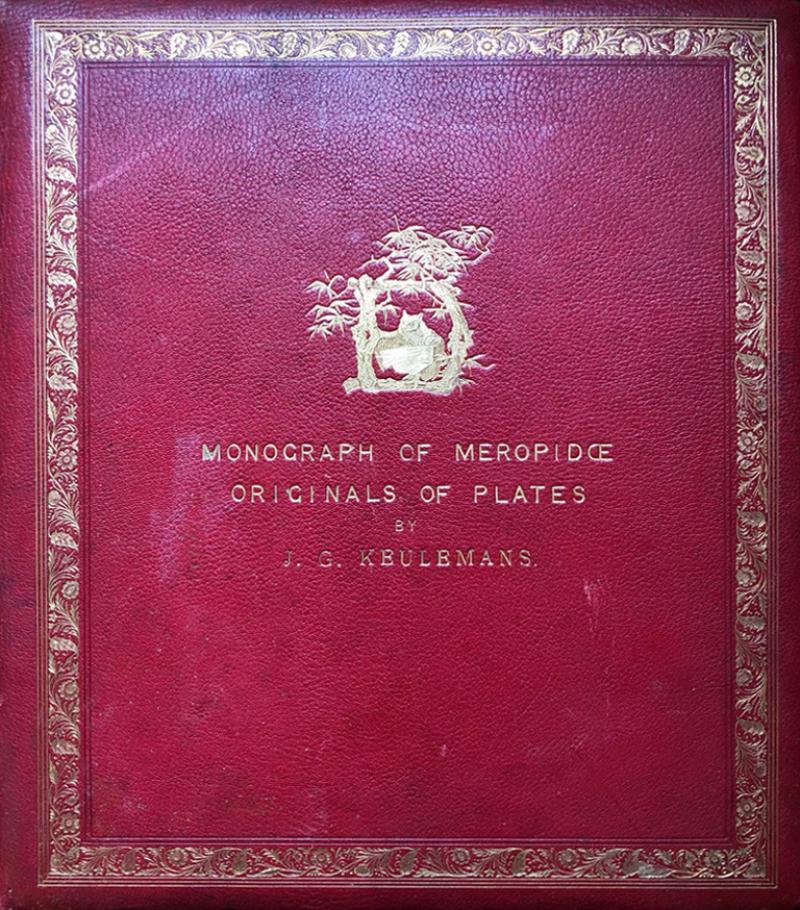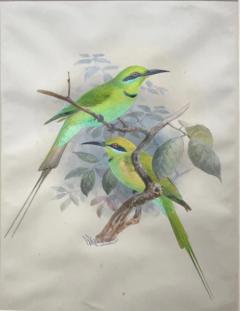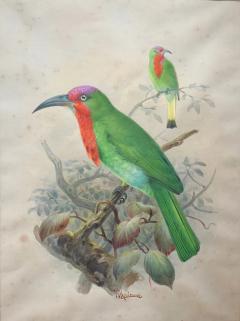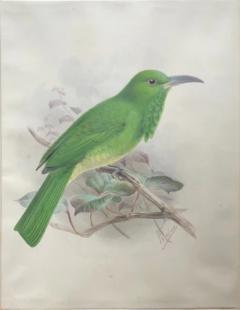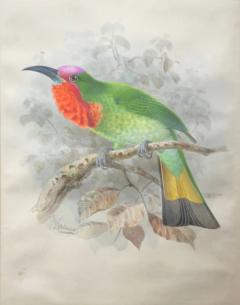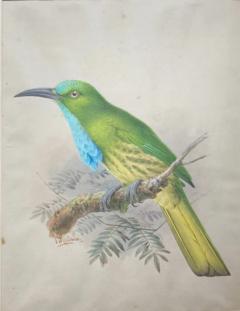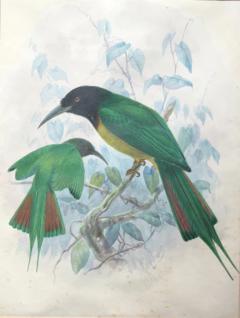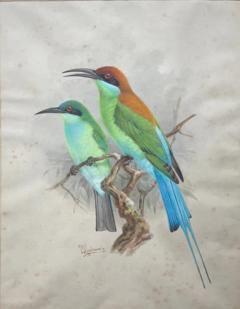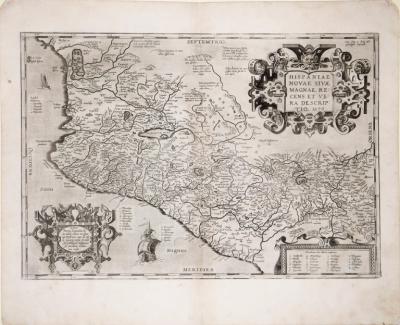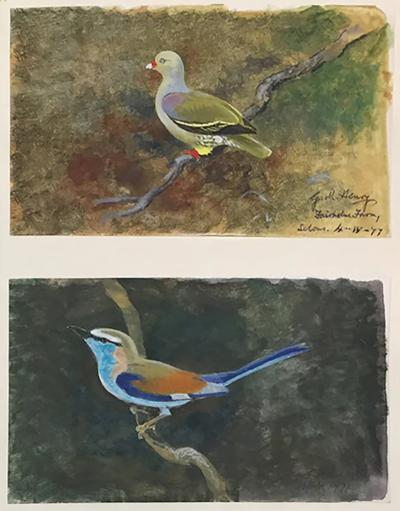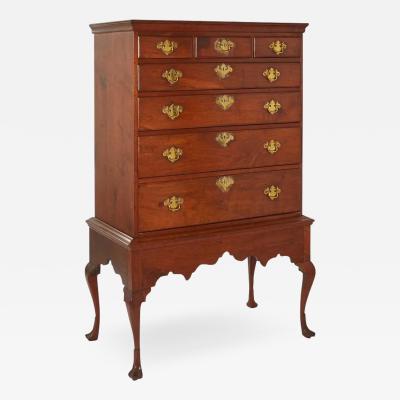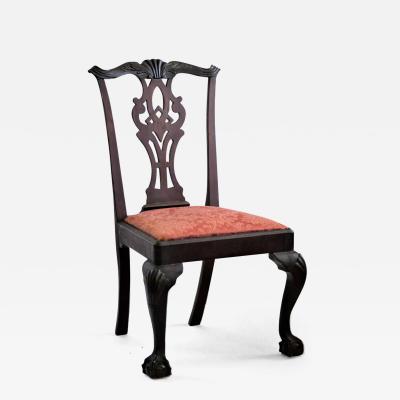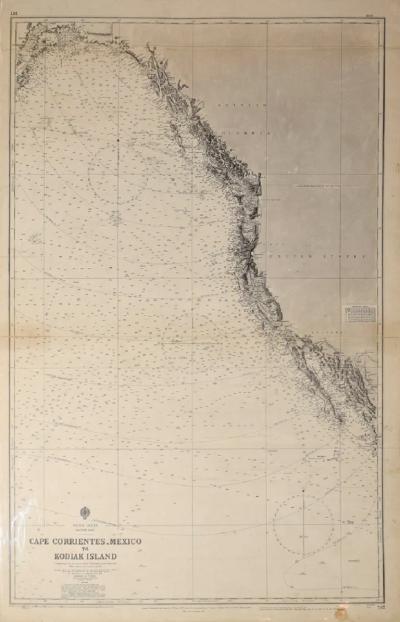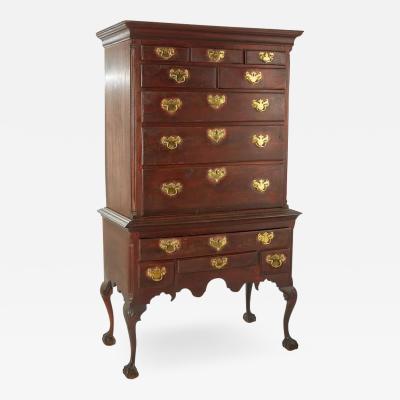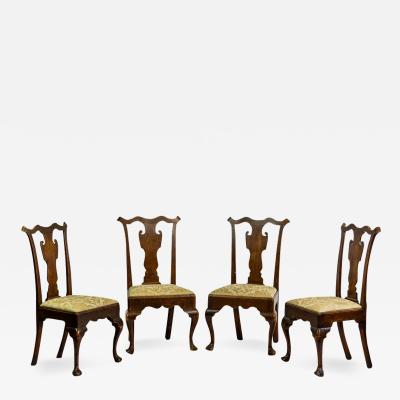Listings / Decorative Arts / Books / Other
PREPARATORY DRAWINGS FOR A MONOGRAPH OF THE MEROPIDAE
-
Description
Johannes Gerardus Keulemans (Dutch, 1842-1912) and
Henry Eeles Dresser (British, 1838-1915)
Preparatory drawings for A Monograph of the Meropidae, or Family of the Bee-Eaters, 1884-1886.
Folio (18 4/8 x 15 4/8 inches).
34 fine watercolors, signed by the artist J.G. Keulemans, painted on card and set within window mounts. Bound for the author in a fine binding of full red morocco gilt, with the title and Dresser’s gilt crest stamped in gilt on the front cover, all edges gilt.
This is a superb set of watercolors by one of the finest artists of ornithology, John Gerard Keulemans.
The Meropidae was published by the author in five parts between 1884 and 1886. The descriptive text of 144 pages by Dresser also included introductory notes by Frank E. Beddard mainly on the anatomy of the species. An important monograph, The Meropidae is one of three major monographs published by Dresser. The others include History of the Birds of Europe (1871-1896), still the largest and most complete work on this subject, and A Monograph of the Coraciidae, 1893. All of these works contain illustrations by Keulemans. Dresser was also the author of over 100 scientific papers on birds, mostly concerned with geographical distribution and new species. His Manual of Palaearctic Birds (1902) was an important contribution to the delimitation of the ranges of Palaearctic birds.
The artist of these fine watercolors, Johannes Gerardus Keulemans (1842-1912), began his career as a taxidermist providing stuffed birds to the State Museum of Natural History at Leiden. The director of that museum encouraged Keulemans to pursue his love of natural history, where he obtained a scientific appointment after an expedition to West Africa in 1865 and 1866. His accomplishments in illustration came to the notice of Richard Bowdler Sharpe, later a director of the British Museum, who encouraged him to move to England.
Keulemans quickly achieved wide recognition and established himself as the most popular bird artist of the late Victorian period. He regularly provided illustrations for “The Ibis” and “The Proceedings of the Zoological Society”. He illustrated many important bird books as well as those by Dresser, including Buller’s A History of the Birds of New Zealand (1873), Shelley’s Monograph of the Sun-Birds (1876-1880), William Vincent Legge’s Birds of Ceylon (1880), Daniel Giraud Elliot’s Monograph of the Hornbills (1887-1892), Richard Bowdler Sharpe’s Monograph on Kingfishers (1868-1871), Henry Seebohm’s Monograph on Thrushes (1902), and Osbert Salvin’s Biologia Centrali-Americana (1879-1904). Keulemans has painted remarkable pictures of extinct birds, like the Choiseul Crested Pigeon, Kangaroo Island Emu, Huia, Stephens Island Wren, Hawaii Oo, Hawaii Mamo, Oahu Oo, Guadalupe Petrel, and the Laughing Owl. All these paintings can be seen in the American Museum of Natural History in New York. A leading figure in ornithological circles.
Henry Eeles Dresser (1838-1915) was elected as a Member of the British Ornithologists’ Union in 1865 and served as its secretary from 1882 to 1888. He was also a member and fellow of the Linnean and Zoological societies of London and an honorary fellow of the American Ornithologists’ Union. He was a close friend of Professor Alfred Newton, Thomas Littleton Powys, 4th Baron Lilford and of Sir Alfred Russel Wallace. He knew all of the leading ornithologists of the day.
He was particularly well-known to European, American and Russian ornithologists. He worked with Alfred Newton on the promotion of a “close time” for British birds, a period, during the 18602, when birds could not be hunted. This early effort aided in the commencement of the bird conservation movement. In spite of Keulemans’ prominence as an ornithologist, this activity had to come second to his business which, from 1870 until 1910, was in the iron business, with premises at 110 Cannon Street in The City. Dresser left England in 1912 in order to live in Cannes for the benefit of his health; he died in Monte Carlo. His collection of birds had been in the Manchester Museum, part of the University of Manchester, since 1899 and was purchased for the museum by JP Thomasson (a Bolton businessman). Dresser’s egg collection was acquired by the museum in 1912. The museum also contains some of Dresser’s correspondence and diaries.
The Bee-Eaters are a group of near passerine birds in the family Meropidae. Most species are found in Africa but others occur in southern Europe, Madagascar, Australia and New Guinea. They are characterized by richly covered plumage, slender bodies and elongated central tail feathers. All are colorful and have long downturned bills and pointed wings, which give them a swallow-like appearance when seen from afar. Fine Bird Books p. 72; Nissen IVB 269; Wood p. 324; Zimmer p. 178; McGie 173
Dresser’s special interest in Bee-eaters and Rollers was fueled by his incentive to write a monograph on each of them. His fascination with Bee-eaters began even before he started working on his volumes on the Birds of Europe (1871-1881). Dresser, however, previously believed D. G. Elliot, his friend and a famed ornithologist, had already begun a study on these species of birds, although this turned out to not be true. It took years before Dresser could gather sufficient material to commence a work on the birds of the Eastern Palearctic Region. Being the sequel to Birds of Europe, he resolved to undertake this monograph on Bee-eaters as a way to make use of his spare time. Little was known of Bee-eaters during his time. Starting in 1882, Dresser built upon a collection of 200 Bee-eater skins, including almost all known species. Additionally, he was able to borrow the collection owned by Captain G. E. Shelly and that of Captain R. G. Wardlaw Ramsay, belonging to the Tweeddale collection. For notes on the anatomy and osteology of the Bee-eaters, Dresser relied on the work of the late Mr. W. A. Rorbes. Due to Rorbes premature death, his successor in the post of Prosecutor to the Zoological Society, Mr. Prank E. Beddard, undertook a portion of the work, including the Introduction to the monograph. Dresser carefully mentions the findings of his fellow naturalists on the anatomy of Bee-eaters, with regard to the oil-glands, muscles, and skulls. These traits were particularly important as they were used to demonstrate the relationship between the Rollers (in the same order of Coraciiformes) and other families of birds, like the kingfishers, trogons, and hornbills. Dresser goes back as far as 1760 to carefully enumerate the Natural History books in which the Bee-eater is mentioned, starting with the works of Brisson. With this, he gives a valuable overview of the discovery, naming, and classification of the species over the previous 120 years.
In these watercolors, most Bee-eaters are depicted in pairs (22 in total), with occasionally a sole juvenile bird (see Pink crowned Bee-eater, Young). Keulemans aims to represent the birds in their natural environment and natural behavior. As their name suggests, Bee-eaters predominantly eat flying insects, especially bees and wasps, which are caught in the air by flight from an open perch. Therefore, the artist depicted several Bee-eaters hunting in this manner (See for instance White Fronted Bee Eater, Mellitophagus bullockoides and Blue Throated Green Bee Eater, Merops cyanophrys). The stinger of the insect is removed by repeatedly hitting and rubbing it on a hard surface. Most Bee-eaters are quite gregarious. They form colonies, nesting in burrows tunneled into vertical sandy banks, often at the side of a river or in flat ground. Keulemans shows various Bee-eaters near water, one of them flying over the water in a gracious manner (see Swallow tailed Bee-eater, Dicrocercus furcatus). The stunning colors of Bee-eaters are hardly matched in the avian world. Their bright colors range from blue, pink, yellow, green, orange, red, and blue, with an iridescence that gives even more depth and shimmer to the plumage. To convey these colors in a convincing manner on paper is a great challenge for any artist. Keulemans did an exceedingly excellent job. His birds are beautifully vibrant and done with incredible detail. Drawing these birds using intense colors can be very difficult. If the coloring is done improperly, it may give the bird a ‘flat’ appearance. If the shading is done excessively, their brightness diminishes. In these watercolors, the transition of colors is done in a very subtle matter, which is especially visible in the green and turquoise parts of the birds, giving them depth and brightness as though they were alive (see for instance Blue Tailed Bee Eater, Merops Philippinus). Even though the plates in the monograph are of high quality, they are by no means at the same level of the watercolors. The details in the lithographs are coarser by far. Since the plates are printed in black, and later colored by hand, they tend to be more ‘grayish’ than the intensely bright works by Keulemans. A very clear example is seen in the Forstens Bee Eater, Meropogon Forsteni. In Keulemans original work, the blue throat has the intense ultramarine color that is unmatched by the illustration in the book.
JOHN GERRARD KEULEMANS (DUTCH, 1842-1912)
One of the foremost ornithological illustrators of the nineteenth-century, John Gerrard Keulemans, has received less recognition than is his due simply because he rarely published his own books, but rather contributed to a number of the most notable bird books of the time. Dutch by origin, he was one of a select band of continental European bird and animal artists to be attracted to England during the middle and latter half of the nineteenth century. Throughout his acclaimed career, his distinctive and exquisitely rendered bird illustrations graced publications including Daniel Giraud Elliot's monographs on the pheasants and hornbills, Henry Eeles Dresser's History of the Birds of Europe, Bowdler Sharpe's monograph on kingfishers, and George E. Shelley's on sunbirds, as well as his own Natural History of the Cage Birds. Keulemans executed and lithographed more than one hundred plates for the British Museum Catalogue of Birds, attesting to his extraordinary diversity and ability to depict birds of widely different species from parrots to birds of prey. His illustrations of birds for works related to geographic regions are equally diverse, covering Great Britain, Europe, Abyssinia, Australia, New Zealand, India, South Africa, and Central America.
Born in Rotterdam in 1842, Keulemans worked for several years at the Leyden Museum. Like his fellow artist Josef Wolf, he was encouraged by the influential Professor Hermann Schlegel, who gave him several important commissions. Like other protegés of Professor Schlegel, he was soon lured away by London's outstanding opportunities, which was then the center for ornithological publications. John Gould had provided the first commissions for Wolf in London, and it was Gould's friend Richard Bowdler Sharpe was responsible for luring Keulemans to England in 1869. By the turn of the century, any author of a bird-book requiring an illustrator almost automatically thought first of Keulemans. Although many of the publications that Keulemans contributed to were ostensibly documentary, his magnificent illustrations inevitably transcended mere science, distinguished by their glorious color and sophisticated compositions.
Keulemans's original work is scarce, and only in his watercolors can one attain a full understanding of his mastery as an ornithological artist. Some Keulemans' original watercolors are in the collection of the British Museum or other institutions, and few become available to private collectors. This magnificent watercolor represents a valuable and unusual opportunity to attain an original work by one of the foremost bird artists working in Victorian Britain. -
More Information
Documentation: Signed Period: 19th Century Styles / Movements: Traditional Incollect Reference #: 615719
Message from Seller:
Founded in 1971, Arader Galleries is the leading dealer of rare maps, prints, books, and watercolors from the 16th to 19th centuries. Visit us at 1016 Madison Avenue, NYC, or contact us at 215.735.8811 | loricohen@aradergalleries.com |















